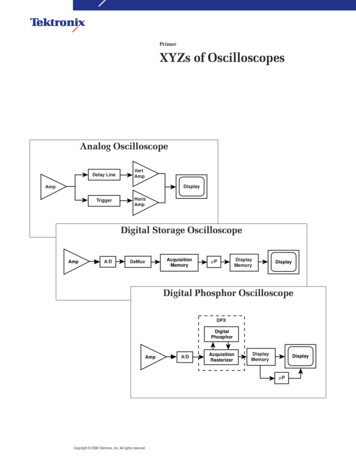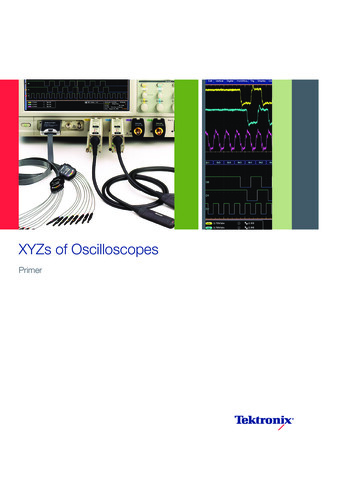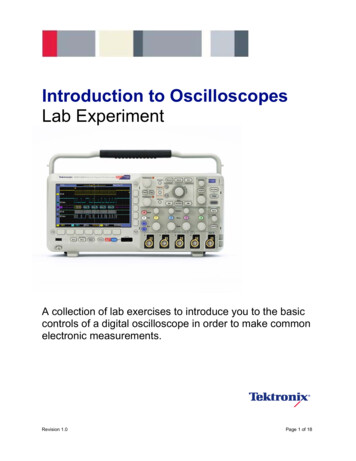
Transcription
PrimerXYZs of OscilloscopesAnalog OscilloscopeDelay LineVertAmpDisplayAmpTriggerHorizAmpDigital Storage MemoryDisplayDigital Phosphor terizerDisplayMemoryDisplayµPCopyright 2000 Tektronix, Inc. All rights reserved.
X Y Zs of OscilloscopesIntroductionThe oscilloscope is an essential tool if you plan to design or repair electronicequipment. It lets you “see” electrical signals.Energy, vibrating particles, and other invisible forces are everywhere in ourphysical universe. Sensors can convert these forces into electrical signals thatyou can observe and study with an oscilloscope. Oscilloscopes let you “see”events that occur in a split second.Why Read This Book?If you are a scientist, engineer, technician, or electronics hobbyist, you shouldknow how to use an oscilloscope. The concepts presented here provide youwith a good starting point.If you are using an oscilloscope for the first time, read this book to get a solidunderstanding of oscilloscope basics. Then, read the manual provided withyour oscilloscope to learn specific information about how to use it in yourwork. After reading this book, you will be able to: Describe how oscilloscopes work Describe the difference between analog, digital storage, and digital phosphoroscilloscopes Describe electrical waveform types Understand basic oscilloscope controls Take simple measurementsIf you come across an unfamiliar term in this book, check the glossary in theback for a definition.This book serves as a useful classroom aid. It includes vocabulary and multiplechoice written exercises on oscilloscope theory and controls. You do not needany mathematical or electronics knowledge. This book emphasizes teaching youabout oscilloscopes – how they work, how to choose the right one, and and howto make it work for you.i
ii
XYZs of OscilloscopesContentsIntroduction· · · · · · · · · · · · · · · · · · · · · · · · · · · · · · · · · · · · · · · · · · · · · · · · · · · · · · · · · · · · · iWhy Read This Book? · · · · · · · · · · · · · · · · · · · · · · · · · · · · · · · · · · · · · · · · · · · · · · · · · · · · · · · · · · · · · · · · · · · · iThe Oscilloscope · · · · · · · · · · · · · · · · · · · · · · · · · · · · · · · · · · · · · · · · · · · · · · · · · · · · · · · · 1What Can You Do With an Oscilloscope? · · · · · · · · · · · · · · · · · · · · · · · · · · · · · · · · · · · · · · · · · · · · · · · · · · · · 2Analog, Digital Storage, and Digital Phosphor Oscilloscopes · · · · · · · · · · · · · · · · · · · · · · · · · · · · · · · · · · · · 2How Oscilloscopes Work · · · · · · · · · · · · · · · · · · · · · · · · · · · · · · · · · · · · · · · · · · · · · · · · · · · · · · · · · · · · · · · · · 3Analog Oscilloscopes · · · · · · · · · · · · · · · · · · · · · · · · · · · · · · · · · · · · · · · · · · · · · · · · · · · · · · · · · · · · · · · · · · 3Digital Storage Oscilloscopes · · · · · · · · · · · · · · · · · · · · · · · · · · · · · · · · · · · · · · · · · · · · · · · · · · · · · · · · · · · · 4Digital Phosphor Oscilloscopes · · · · · · · · · · · · · · · · · · · · · · · · · · · · · · · · · · · · · · · · · · · · · · · · · · · · · · · · · · 4Sampling Methods · · · · · · · · · · · · · · · · · · · · · · · · · · · · · · · · · · · · · · · · · · · · · · · · · · · · · · · · · · · · · · · · · · · · 5Real-Time Sampling with Interpolation · · · · · · · · · · · · · · · · · · · · · · · · · · · · · · · · · · · · · · · · · · · · · · · · · · · 5Oscilloscope Terminology · · · · · · · · · · · · · · · · · · · · · · · · · · · · · · · · · · · · · · · · · · · · · · · · · 7Measurement Terms · · · · · · · · · · · · · · · · · · · · · · · · · · · · · · · · · · · · · · · · · · · · · · · · · · · · · · · · · · · · · · · · · · · · · 7Types of Waves · · · · · · · · · · · · · · · · · · · · · · · · · · · · · · · · · · · · · · · · · · · · · · · · · · · · · · · · · · · · · · · · · · · · · · · · · 7Sine Waves · · · · · · · · · · · · · · · · · · · · · · · · · · · · · · · · · · · · · · · · · · · · · · · · · · · · · · · · · · · · · · · · · · · · · · · · · · 7Square and Rectangular Waves · · · · · · · · · · · · · · · · · · · · · · · · · · · · · · · · · · · · · · · · · · · · · · · · · · · · · · · · · · 8Sawtooth and Triangle Waves · · · · · · · · · · · · · · · · · · · · · · · · · · · · · · · · · · · · · · · · · · · · · · · · · · · · · · · · · · · 8Step and Pulse Shape · · · · · · · · · · · · · · · · · · · · · · · · · · · · · · · · · · · · · · · · · · · · · · · · · · · · · · · · · · · · · · · · · 8Complex Waves · · · · · · · · · · · · · · · · · · · · · · · · · · · · · · · · · · · · · · · · · · · · · · · · · · · · · · · · · · · · · · · · · · · · · · 8Waveform Measurements · · · · · · · · · · · · · · · · · · · · · · · · · · · · · · · · · · · · · · · · · · · · · · · · · · · · · · · · · · · · · · · · · 9Frequency and Period · · · · · · · · · · · · · · · · · · · · · · · · · · · · · · · · · · · · · · · · · · · · · · · · · · · · · · · · · · · · · · · · · 9Voltage · · · · · · · · · · · · · · · · · · · · · · · · · · · · · · · · · · · · · · · · · · · · · · · · · · · · · · · · · · · · · · · · · · · · · · · · · · · · · 9Phase · · · · · · · · · · · · · · · · · · · · · · · · · · · · · · · · · · · · · · · · · · · · · · · · · · · · · · · · · · · · · · · · · · · · · · · · · · · · · · · 9Performance Terms · · · · · · · · · · · · · · · · · · · · · · · · · · · · · · · · · · · · · · · · · · · · · · · · · · · · · · · · · · · · · · · · · · · · · · 9Bandwidth · · · · · · · · · · · · · · · · · · · · · · · · · · · · · · · · · · · · · · · · · · · · · · · · · · · · · · · · · · · · · · · · · · · · · · · · · · 9Rise Time · · · · · · · · · · · · · · · · · · · · · · · · · · · · · · · · · · · · · · · · · · · · · · · · · · · · · · · · · · · · · · · · · · · · · · · · · · · 9Effective Bits · · · · · · · · · · · · · · · · · · · · · · · · · · · · · · · · · · · · · · · · · · · · · · · · · · · · · · · · · · · · · · · · · · · · · · · · 9Frequency Response · · · · · · · · · · · · · · · · · · · · · · · · · · · · · · · · · · · · · · · · · · · · · · · · · · · · · · · · · · · · · · · · · 10Vertical Sensitivity · · · · · · · · · · · · · · · · · · · · · · · · · · · · · · · · · · · · · · · · · · · · · · · · · · · · · · · · · · · · · · · · · · · 10Sweep Speed · · · · · · · · · · · · · · · · · · · · · · · · · · · · · · · · · · · · · · · · · · · · · · · · · · · · · · · · · · · · · · · · · · · · · · · 10Gain Accuracy · · · · · · · · · · · · · · · · · · · · · · · · · · · · · · · · · · · · · · · · · · · · · · · · · · · · · · · · · · · · · · · · · · · · · · 10Time Base or Horizontal Accuracy · · · · · · · · · · · · · · · · · · · · · · · · · · · · · · · · · · · · · · · · · · · · · · · · · · · · · · 10Sample Rate · · · · · · · · · · · · · · · · · · · · · · · · · · · · · · · · · · · · · · · · · · · · · · · · · · · · · · · · · · · · · · · · · · · · · · · · 10ADC Resolution (or Vertical Resolution) · · · · · · · · · · · · · · · · · · · · · · · · · · · · · · · · · · · · · · · · · · · · · · · · · 10Record Length · · · · · · · · · · · · · · · · · · · · · · · · · · · · · · · · · · · · · · · · · · · · · · · · · · · · · · · · · · · · · · · · · · · · · · 10Waveform Capture Rate · · · · · · · · · · · · · · · · · · · · · · · · · · · · · · · · · · · · · · · · · · · · · · · · · · · · · · · · · · · · · · · 10Setting Up · · · · · · · · · · · · · · · · · · · · · · · · · · · · · · · · · · · · · · · · · · · · · · · · · · · · · · · · · · · · · 11Grounding · · · · · · · · · · · · · · · · · · · · · · · · · · · · · · · · · · · · · · · · · · · · · · · · · · · · · · · · · · · · · · · · · · · · · · · · · · · · 11Ground the Oscilloscope · · · · · · · · · · · · · · · · · · · · · · · · · · · · · · · · · · · · · · · · · · · · · · · · · · · · · · · · · · · · · · 11Ground Yourself · · · · · · · · · · · · · · · · · · · · · · · · · · · · · · · · · · · · · · · · · · · · · · · · · · · · · · · · · · · · · · · · · · · · · 11Setting the Controls · · · · · · · · · · · · · · · · · · · · · · · · · · · · · · · · · · · · · · · · · · · · · · · · · · · · · · · · · · · · · · · · · · 11Probes · · · · · · · · · · · · · · · · · · · · · · · · · · · · · · · · · · · · · · · · · · · · · · · · · · · · · · · · · · · · · · · · · · · · · · · · · · · · · · · 12“Intelligent” Probe Interfaces · · · · · · · · · · · · · · · · · · · · · · · · · · · · · · · · · · · · · · · · · · · · · · · · · · · · · · · · · · 12Using Passive Probes · · · · · · · · · · · · · · · · · · · · · · · · · · · · · · · · · · · · · · · · · · · · · · · · · · · · · · · · · · · · · · · · · 12Using Active Probes · · · · · · · · · · · · · · · · · · · · · · · · · · · · · · · · · · · · · · · · · · · · · · · · · · · · · · · · · · · · · · · · · · 13Using Current Probes · · · · · · · · · · · · · · · · · · · · · · · · · · · · · · · · · · · · · · · · · · · · · · · · · · · · · · · · · · · · · · · · · 13Where to Clip the Ground Clip · · · · · · · · · · · · · · · · · · · · · · · · · · · · · · · · · · · · · · · · · · · · · · · · · · · · · · · · · 13Compensating the Probe · · · · · · · · · · · · · · · · · · · · · · · · · · · · · · · · · · · · · · · · · · · · · · · · · · · · · · · · · · · · · · · · · 14iii
The Controls · · · · · · · · · · · · · · · · · · · · · · · · · · · · · · · · · · · · · · · · · · · · · · · · · · · · · · · · · · · 15Display Controls · · · · · · · · · · · · · · · · · · · · · · · · · · · · · · · · · · · · · · · · · · · · · · · · · · · · · · · · · · · · · · · · · · · · · · · 15Vertical Controls · · · · · · · · · · · · · · · · · · · · · · · · · · · · · · · · · · · · · · · · · · · · · · · · · · · · · · · · · · · · · · · · · · · · · · · 15Position and Volts per Division · · · · · · · · · · · · · · · · · · · · · · · · · · · · · · · · · · · · · · · · · · · · · · · · · · · · · · · · 15Input Coupling · · · · · · · · · · · · · · · · · · · · · · · · · · · · · · · · · · · · · · · · · · · · · · · · · · · · · · · · · · · · · · · · · · · · · · 15Bandwidth Limit · · · · · · · · · · · · · · · · · · · · · · · · · · · · · · · · · · · · · · · · · · · · · · · · · · · · · · · · · · · · · · · · · · · · 16Alternate and Chop Display · · · · · · · · · · · · · · · · · · · · · · · · · · · · · · · · · · · · · · · · · · · · · · · · · · · · · · · · · · · 16Math Operations · · · · · · · · · · · · · · · · · · · · · · · · · · · · · · · · · · · · · · · · · · · · · · · · · · · · · · · · · · · · · · · · · · · · 17Horizontal Controls · · · · · · · · · · · · · · · · · · · · · · · · · · · · · · · · · · · · · · · · · · · · · · · · · · · · · · · · · · · · · · · · · · · · 17Position and Seconds per Division · · · · · · · · · · · · · · · · · · · · · · · · · · · · · · · · · · · · · · · · · · · · · · · · · · · · · 17Time Base Selections · · · · · · · · · · · · · · · · · · · · · · · · · · · · · · · · · · · · · · · · · · · · · · · · · · · · · · · · · · · · · · · · · 17Trigger Position · · · · · · · · · · · · · · · · · · · · · · · · · · · · · · · · · · · · · · · · · · · · · · · · · · · · · · · · · · · · · · · · · · · · · 17Zoom · · · · · · · · · · · · · · · · · · · · · · · · · · · · · · · · · · · · · · · · · · · · · · · · · · · · · · · · · · · · · · · · · · · · · · · · · · · · · · 18XY Mode · · · · · · · · · · · · · · · · · · · · · · · · · · · · · · · · · · · · · · · · · · · · · · · · · · · · · · · · · · · · · · · · · · · · · · · · · · · 18The Z Axis · · · · · · · · · · · · · · · · · · · · · · · · · · · · · · · · · · · · · · · · · · · · · · · · · · · · · · · · · · · · · · · · · · · · · · · · · 18XYZ Mode · · · · · · · · · · · · · · · · · · · · · · · · · · · · · · · · · · · · · · · · · · · · · · · · · · · · · · · · · · · · · · · · · · · · · · · · · 18Trigger Controls · · · · · · · · · · · · · · · · · · · · · · · · · · · · · · · · · · · · · · · · · · · · · · · · · · · · · · · · · · · · · · · · · · · · · · · · 18Trigger Level and Slope · · · · · · · · · · · · · · · · · · · · · · · · · · · · · · · · · · · · · · · · · · · · · · · · · · · · · · · · · · · · · · · 19Trigger Sources · · · · · · · · · · · · · · · · · · · · · · · · · · · · · · · · · · · · · · · · · · · · · · · · · · · · · · · · · · · · · · · · · · · · · · 19Trigger Modes · · · · · · · · · · · · · · · · · · · · · · · · · · · · · · · · · · · · · · · · · · · · · · · · · · · · · · · · · · · · · · · · · · · · · · · 19Trigger Coupling · · · · · · · · · · · · · · · · · · · · · · · · · · · · · · · · · · · · · · · · · · · · · · · · · · · · · · · · · · · · · · · · · · · · 20Trigger Holdoff · · · · · · · · · · · · · · · · · · · · · · · · · · · · · · · · · · · · · · · · · · · · · · · · · · · · · · · · · · · · · · · · · · · · · · 20Digitizing Oscilloscope Triggers · · · · · · · · · · · · · · · · · · · · · · · · · · · · · · · · · · · · · · · · · · · · · · · · · · · · · · · · 20Acquisition Controls for Digitizing Oscilloscopes · · · · · · · · · · · · · · · · · · · · · · · · · · · · · · · · · · · · · · · · · · · · 21Acquisition Modes · · · · · · · · · · · · · · · · · · · · · · · · · · · · · · · · · · · · · · · · · · · · · · · · · · · · · · · · · · · · · · · · · · · 21Stopping and Starting the Acquisition System · · · · · · · · · · · · · · · · · · · · · · · · · · · · · · · · · · · · · · · · · · · · 22Sampling Methods · · · · · · · · · · · · · · · · · · · · · · · · · · · · · · · · · · · · · · · · · · · · · · · · · · · · · · · · · · · · · · · · · · · 22Other Controls · · · · · · · · · · · · · · · · · · · · · · · · · · · · · · · · · · · · · · · · · · · · · · · · · · · · · · · · · · · · · · · · · · · · · · · · · 22Measurement Techniques · · · · · · · · · · · · · · · · · · · · · · · · · · · · · · · · · · · · · · · · · · · · · · · · 23The Display · · · · · · · · · · · · · · · · · · · · · · · · · · · · · · · · · · · · · · · · · · · · · · · · · · · · · · · · · · · · · · · · · · · · · · · · · · · 23Voltage Measurements · · · · · · · · · · · · · · · · · · · · · · · · · · · · · · · · · · · · · · · · · · · · · · · · · · · · · · · · · · · · · · · · · · 23Time and Frequency Measurements · · · · · · · · · · · · · · · · · · · · · · · · · · · · · · · · · · · · · · · · · · · · · · · · · · · · · · · 24Pulse and Rise Time Measurements · · · · · · · · · · · · · · · · · · · · · · · · · · · · · · · · · · · · · · · · · · · · · · · · · · · · · · · 24Phase Shift Measurements · · · · · · · · · · · · · · · · · · · · · · · · · · · · · · · · · · · · · · · · · · · · · · · · · · · · · · · · · · · · · · · 25Waveform Measurements with Digitizing Oscilloscopes · · · · · · · · · · · · · · · · · · · · · · · · · · · · · · · · · · · · · · 26What’s Next? · · · · · · · · · · · · · · · · · · · · · · · · · · · · · · · · · · · · · · · · · · · · · · · · · · · · · · · · · · · · · · · · · · · · · · · · · · 26Written Exercises · · · · · · · · · · · · · · · · · · · · · · · · · · · · · · · · · · · · · · · · · · · · · · · · · · · · · · · 27Part I Exercises · · · · · · · · · · · · · · · · · · · · · · · · · · · · · · · · · · · · · · · · · · · · · · · · · · · · · · · · · · · · · · · · · · · · · · · · · 28Part II Exercises · · · · · · · · · · · · · · · · · · · · · · · · · · · · · · · · · · · · · · · · · · · · · · · · · · · · · · · · · · · · · · · · · · · · · · · · 30Answers to Written Exercises · · · · · · · · · · · · · · · · · · · · · · · · · · · · · · · · · · · · · · · · · · · · · · · · · · · · · · · · · · · · · 34Glossary · · · · · · · · · · · · · · · · · · · · · · · · · · · · · · · · · · · · · · · · · · · · · · · · · · · · · · · · · · · · · · 35iv
The OscilloscopeWhat is an oscilloscope, what can you do with it,and how does it work? This section answers thesefundamental questions.The oscilloscope is basically a graph-displayingdevice – it draws a graph of an electrical signal (seeFigure 1). In most applications the graph shows howsignals change over time: the vertical (Y) axis represents voltage and the horizontal (X) axis representstime. The intensity or brightness of the display issometimes called the Z axis. This simple graph cantell you many things about a signal. Here are a few: You can determine the time and voltage values ofa signal You can calculate the frequency of an oscillatingsignal You can see the “moving parts” of a circuit represented by the signal You can tell how often a particular portion of thesignal is occurring relative to other portions You can tell if a malfunctioning component isdistorting the signal You can find out how much of a signal is directcurrent (DC) or alternating current (AC) You can tell how much of the signal is noise andwhether the noise is changing with timeAn oscilloscope’s front panel includes a displayscreen and the knobs, buttons, switches, and indicators used to control signal acquisition and display.Front-panel controls normally are divided intoVertical, Horizontal, and Trigger sections, and inaddition, there are display controls and inputconnectors. See if you can locate these front-panelsections in Figures 2 and 3 as well as on youroscilloscope.Figure 1. X, Y, and Z Components of a displayed waveform.Figure 2. The TAS 465 Analog Oscilloscope front panel.1
Figure 3. The TDS 784D Digital Phosphor Oscilloscope front panel.What Can You Do With anOscilloscope?Oscilloscopes are used by everyone from televisionrepair technicians to physicists. They are indispensable for anyone designing or repairing electronicequipment.The usefulness of an oscilloscope is not limited tothe world of electronics. With the proper transducer,an oscilloscope can measure all kinds of phenomena.A transducer is a device that creates an electricalsignal in response to physical stimuli, such assound, mechanical stress, pressure, light, or heat. Forexample, a microphone is a transducer that convertssound to an electrical signal.An automotive engineer uses an oscilloscope tomeasure engine vibrations. A medical researcheruses an oscilloscope to measure brain waves. Thepossibilities are endless.Analog, Digital Storage, and DigitalPhosphor OscilloscopesElectronic equipment can be divided into two types:analog and digital. Analog equipment works withcontinuously variable voltages, while digital equipment works with discrete binary numbers that mayrepresent voltage samples. For example, a conven-tional phonograph is an analog device, while acompact disc player is a digital device.Oscilloscopes also come in analog and digitizingtypes (see Figure 5). Fundamentally an analog oscilloscope works by applying the measured signalvoltage directly to an electron beam moving acrossthe oscilloscope screen (usually a cathode-ray tube,CRT). The back side of the screen is treated with acoating that phosphoresces wherever the electronbeam hits it. The signal voltage deflects the beam upand down proportionally, tracing the waveform onthe screen. The more frequently the beam hits aparticular screen location, the more brightly it glows.This gives an immediate picture of the waveform.The range of frequencies an analog scope can displayis limited by the CRT. At very low frequencies, thesignal appears as a bright, slow-moving dot that’sdifficult to distinguish as a waveform. At highfrequencies, the CRT’s “writing speed” defines thelimit. When the signal frequency exceeds the CRT’swriting speed, the display becomes too dim to see.The fastest analog scopes can display frequencies upto about 1 GHz.In contrast, a digitizing oscilloscope uses an analogto-digital converter (ADC) to convert the voltagebeing measured into digital information. The digitizing scope acquires the waveform as a series ofFigure 4. An example of scientific data gathered by an oscilloscope.2
samples. It stores these samples until it accumulatesenough samples to describe a waveform, and then reassembles the waveform for viewing on the screen.The conventional digitizing scope is known as aDSO – Digital Storage Oscilloscope. Its displaydoesn’t rely on luminous phosphor; instead, it uses araster-type screen.Recently a third major oscilloscope architecture hasemerged: the Digital Phosphor Oscilloscope (DPO).The DPO is a digitizing scope that f
XYZs of Oscilloscopes The oscilloscope is an essential tool if you plan to design or repair electronic equipment. It lets you “see” electrical signals. Energy, vibrating particles, and other invisible forces are everywhere in our physical universe. Sensors can convert these forces into electrical signals thatFile Size: 621KB











